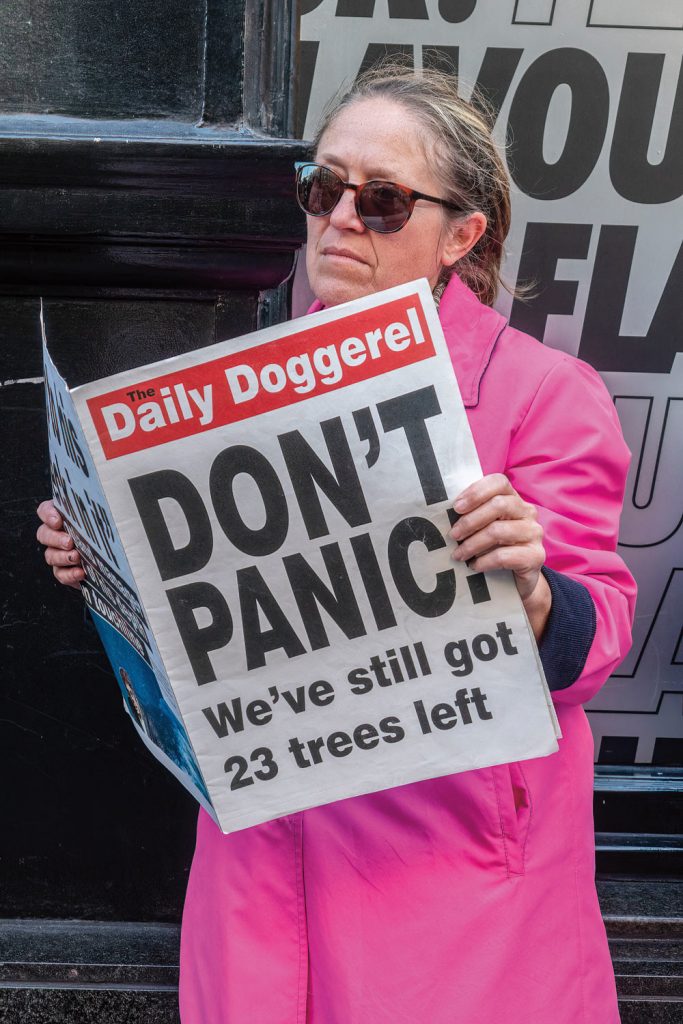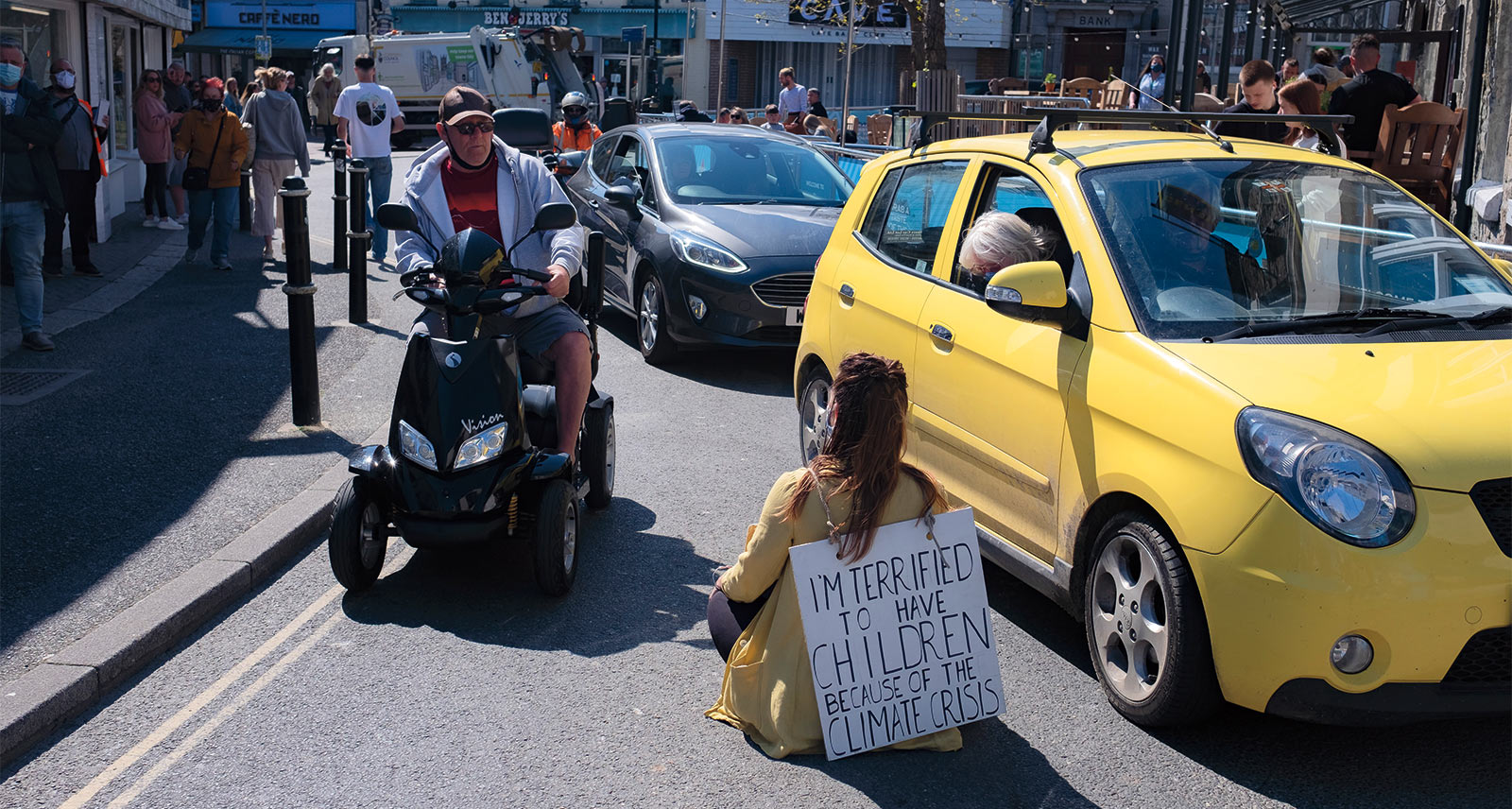I was a climate-anxious undergraduate before the concept of climate anxiety really caught on. A decade ago, when I told my friends and family I was deeply worried about warming oceans, plastic pollution, and climate denialism, they often asked, gently, “Okay, but what’s really going on?” They couldn’t understand the emotional intensity of my concern and thought I was being dramatic or deflecting from something else troubling me. Sometimes, I wondered if anyone else really understood what it felt like to watch the clock tick down toward probable doom.
Now, I know that many people do understand and relate to the effects of climate change on mental health and well-being. In the years since my early experience with climate anxiety, the term’s use has skyrocketed and a new taxonomy has emerged to capture its various nuances, such as “eco-grief,” “psychoterratic illness,” “climate trauma,” and “solastalgia.” In 2020, a study by the American Psychological Association found nearly half of young adults aged 18 to 34 feel stress over climate change daily. A recent study of Nunatsiavut found longer periods of warm temperatures significantly increased mental health clinic visits in Inuit communities. And a September 2021 Bath University survey of over 10,000 16-to-25-year-olds across 10 countries found that 75 per cent believe “the future is frightening.”
Climate anxiety is a kind of suffering; fearing the future is a terrible burden. However, around 2016, when I started to see studies and articles about climate anxiety appear more frequently in the media, I interpreted the rise as indicative of a positive shift away from climate denialism and toward a non-partisan awareness that climate change is happening and will impact us all. Simply having a collective understanding of the issue would, I thought, be unifying; together we can fight the major causes of environmental degradation. We can transition out of fossil fuel−based economies and address the inequalities of wealth and power that both underpin the causes of climate change and condemn our planet’s most vulnerable people to its most devastating and immediate effects. “Now,” I thought, “we are all on the same page.”

Turns out I was not exactly right about that. It is becoming increasingly clear that climate anxiety can affect us all very differently. For those with milder cases, like me, it can be stressful, though manageable — even providing motivation to make eco-friendly lifestyle changes or pursue advocacy work. In more severe cases, however, climate anxiety can cause intense anger, shame, and fear. Sometimes, it can bring out the worst in people.
“Ray observed something else among some of her students: an extreme, desperate panic that led them to make over-the-top, explosive statements about their fears of resource scarcity or surging populations…”
It was around 2015 that Sarah Jaquette Ray, author of A Field Guide to Climate Anxiety and leader of the Environmental Studies program at Humboldt State University in California, noticed a shift in her students. “The material was just so difficult for them [emotionally],” she says. “And it was really becoming intrusive into our ability to do our classes.”
Like many climate scholars, Ray originally intended to help people understand and care more about climate change. But she realized something wasn’t working. Her students began expressing feelings of despair, guilt, and complicity — sometimes having existential breakdowns in class or struggling to attend at all. “We sent them over the edge to the point of apathy and nihilism,” says Ray. “And I was thinking that they were not going to be able to do stuff that the world needed them to do if they couldn’t even get to class, much less graduate.”

Yet there was more going on in her classes than just climate doomism (a hopeless mindset in which the perceived inevitability of doom justifies inaction). Ray observed something else among some of her students: an extreme, desperate panic that led them to make over-the-top, explosive statements about their fears of resource scarcity or surging populations. Someone once even admitted to liking the idea of a green dictatorship. Some of the things they said made Ray think, “This is why Paul Ehrlich wrote The Population Bomb.”
The Population Bomb, published in 1968, is a tirade against population growth in poor countries that predicted, as Ehrlich once said, an “utter breakdown of the capacity of the planet to support humanity” before the sun rose on the ’90s. The book’s tone is one of apocalyptic alarm. More alarm — and countless human rights abuses — followed its publication.
The stories we believe about climate change have real-world effects. As panic about overpopulation intersected with eugenics movements in the mid-20th century, millions faced discriminatory, forced, and frequently unsafe sterilizations in Mexico, India, Bolivia, Peru, Indonesia, and Bangladesh, among other places (in Canada, Indigenous women have been forcibly sterilized as recently as 2018). In countries including Pakistan and Taiwan, health workers’ salaries were at times contingent on the number of IUDs they inserted into women. These attacks on the marginalized were waged in the name of a problem that improvements in women’s rights and access to healthcare and contraception ultimately solved. Today, global birth rates are falling, and experts anticipate shrinking populaces in nearly every country by the end of the century. Even now, nations including Japan and Canada require immigration to combat the social and economic problems presented by their aging populations.
In short, The Population Bomb’s narrative was hysterical, racist, and wrong. The biggest threat to humanity and the environment isn’t population growth — it’s our reliance on extracting and burning fossil fuels. We now know that just 100 investors and state-owned fossil fuel companies are responsible for 70 per cent of the world’s historical greenhouse gas emissions, and that the wealthiest one per cent of the world’s population is responsible for more than double the emissions of the poorest 50 per cent.
Yet the false belief that overpopulation is the main cause of environmental degradation (also known as Malthusianism, for the British economist Thomas Robert Malthus) persists. Depending on your perspective, it’s either extremely convincing or extremely convenient to the far right, who, as climate denialism has become a harder sell, are instead nurturing the toxic seeds of eco-fascism.
So what is eco-fascism, exactly? To the white supremacist terrorists accused of, in 2019, murdering of 74 people between them in El Paso, Texas, and Christchurch, New Zealand, it was a twisted rationale. “The environment is getting worse by the year,” wrote the El Paso shooter in his manifesto. “Most of y’all are just too stubborn to change your lifestyle. So the next logical step is to decrease the number of people in America using resources.” The Christ- church shooter identified as an eco-fascist worried about climate change, overpopulation, and immigration. “They are the same issue, the environment is being destroyed by overpopulation, we Europeans are one of the groups that are not overpopulating the world,” he wrote. “The invaders are the ones overpopulating the world. Kill the invaders, kill the overpopulation and by doing so save the environment.”
Eco-fascism has been called “the greening of hate” and broadly applies to the use of ecological rationales to justify the harm, subjugation, or exclusion of minorities. It provides a faulty veneer of logic to the idea of an ecological “purge”: a kind of “righteous” environmental genocide in which many must die in climate catastrophe for the planet to rebalance and heal (also known as “lifeboat ethics”). Fascism is an anxious ideology. It flourishes when fear and anger can be misdirected toward a specific enemy who its proponents see as ruining their society, taking their resources, robbing them of their comforts and advantages. Eco-fascism can look like militarized border walls, isolationism, resource hoarding, and enforcing racist policies — such as those rejecting climate migrants or opposing multiculturalism in the name of conservation. It can even subtly manifest in the kind of quips that caught on earlier in the COVID-19 pandemic about humans being “the real virus,” which insinuate that at least some of us ought to be cleared away to “disinfect” the planet.
“I fear that in the future there’s going to be more strategic use of [eco-fascistic arguments against immigration] by the far right, but also that there will be people who believe them who aren’t really into it for perfidious reasons, but perhaps because they are too easy to accept,” says Betsy Hartmann, author of The America Syndrome, a 2017 book about how end-times thinking influences politics. “Unless you’re demographically literate.”
The point is, people who are not deliberately malicious actors or consciously xenophobic can still be seduced by apparent “solutions” to climate change that are inherently fascistic. What kinds of people might find the protectionist arguments of eco-fascism compelling? Well, for example, people who feel threatened and who want and have the option to be protected. People like, potentially, some of Ray’s climate-anxious students.
For her part, Ray believes unanalyzed climate anxiety can manifest among the privileged as a desire to retain their favourable status quo. “The dog whistle potential of climate anxiety is that it can [sometimes] be the experience of people who have been insulated from existential threats in the past and are all of a sudden experiencing the prospect of an unlivable future for the first time,” says Ray. She believes in the importance of considering climate anxiety in the context of race and power: “Who gets the space to talk about this stuff and whose vulnerability is more important in these conversations?” Focusing on the climate anxiety of those in positions of privilege can overshadow the experiences of people on the front lines of climate change — like Indigenous nations within Canada who have been ringing alarm bells on ecological degradation for years to little effect — and distract even more from their urgent needs.
Of course, not everyone who experiences climate anxiety will be drawn to eco-fascist logic. Yet for us to ensure we avoid it at a cultural level, we must be able to not only spot its rhetorics and proposals but also understand the ways our emotions can distort our perception of reality and make us susceptible to those with a stake in our politics.
“We can have all the science in the world. We can have all the research, all the programs out there, new technology that theoretically could address this [climate] crisis. And what it’s really going to come down to is human emotions, thoughts, and behaviour,” says Andrew Bryant, a Seattle-based psycho-therapist specializing in how climate change affects mental health. Some emotionally intelligent people are consciously thinking about how climate anxiety may be affecting them, and thus are better equipped to handle it in productive, healthy ways, says Bryant. Others are not so self-aware. “They’re reading the news and responding to disasters and experiencing anxiety without even naming it,” he says. “And that’s going to be unquestioned: ‘I need to take care of myself and my people.’ And historically, in those types of situations, a percentage of the population turns toward xenophobia, racism, protection- ism.” Unchecked emotions could play into a contemporary rise in eco-fascism, “and if we don’t talk about it, we won’t have much say in what happens,” he says.

“…Someone once even admitted to liking the idea of a green dictatorship.”
We must talk about our fear — how it feels to think, as 56 per cent of respondents to the Bath study do, that “humanity is doomed.” It behooves us to be aware that blind panic can be exploited by those who wed socially regressive, unjust politics with concern for the environment. And it can reassure us to understand that our fears are not irrational, but that they also don’t need to dominate us; we can be distressed by what threatens our future without abandoning our hope for it. We must also talk about our hope.
“People have long been afraid that if you talk about solutions that are actually happening, that somehow you’ll create complacency,” says Elin Kelsey, a scholar and educator at the University of Victoria, and the author of 2020’s Hope Matters. Yet focusing exclusively on problems can lead to apathy. “It’s really paramount that we focus on the kinds of solutions that are emerging and look at ways of amplifying them in real time,” she says — and not wishful-thinking, naively optimistic solutions but facts. For instance, in 2009, Kelsey was part of a team that pushed the U.S. government to create what was then the world’s largest protected marine area. Today, it’s not even in the top 10. “Now [in Canada] there’s this big movement to protect 25 per cent per cent of land and water by 2025, 30 per cent by 2030. Those are numbers we were not talking about [back then].” Additionally, Kelsey points to the recovery of humpback whales (which contribute to carbon capture), a huge increase in plant-based diets in the West, the climate– and social justice–centric priorities of the young, and investors successfully pushing corporations to adopt climate-friendly policies as some examples of positive shifts.
Looking at optimistic trends helps us “get away from the starting-line fallacy, which is that all the hard work lies ahead, and that we haven’t done anything,” says Kelsey. There is certainly more to do, but acknowledging the progress that is being made empowers us to continue working toward the tenable goal of a future that’s better than our past.
“We were able to get rid of slavery, we were able to get rid of manifest destiny, we were able to get rid of the divine right of kings — all of these things which were thought of as not even human constructs but given by God. Something like the fossil fuel industry is very much a human creation. It certainly can be changed,” notes Ray. “Every time I talk about climate anxiety, I want to scream from the rooftops, ‘This is not the only inevitable reality!’”
Ray’s words echo with those I turn over in my own mind whenever I feel the creep of climate anxiety these days, penned by the activist and author Arundhati Roy: “Another world is not only possible, she is on her way. On a quiet day, I can hear her breathing.”



